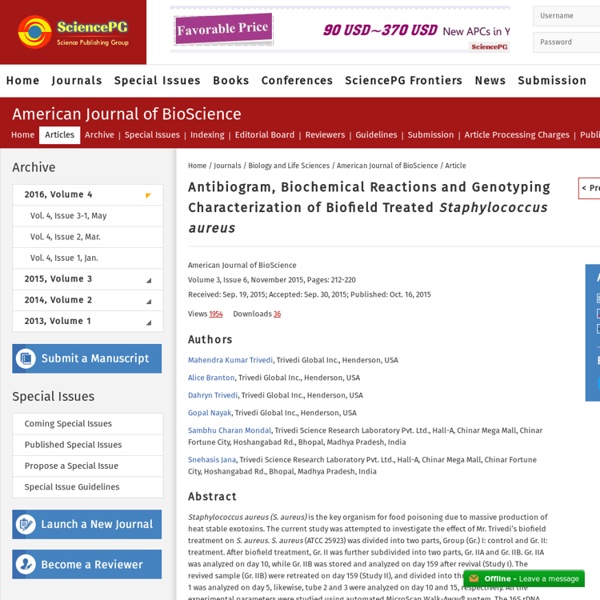Antibiogram, Biochemical Reactions and Genotyping Characterization of Biofield Treated Staphylococcus aureus
Share this: Embed* Cite this: Trivedi, Mahendra Kumar (2015): Antibiogram, Biochemical Reactions and Genotyping Characterization of Biofield Treated Staphylococcus aureus. figshare. Retrieved 06:33, Dec 04, 2015 (GMT)
Publication meta - Characterization of Physical, Thermal and Spectral Properties of Biofield Treated 2,6-Dichlorophenol - Publications
2,6-Dichlorophenol (2,6-DCP) is a compound used for the synthesis of chemicals and pharmaceutical agents. The present work is intended to evaluate the impact of Mr. Trivedi's biofield energy treatment on physical, thermal and spectral properties of the 2,6-DCP. The control and treated 2,6-DCP were characterized by various analytical techniques such as X-ray diffraction (XRD), differential scanning calorimetry (DSC), thermogravimetric analysis (TGA), Fourier transform infrared (FT-IR) spectroscopy, and ultra violet-visible spectroscopy (UV-vis) analysis.
Evaluation of Phenotyping and Genotyping Characterization of Serratia marcescens after Biofield Treatment - Trivedi Science
Abstract Serratia marcescens (S. marcescens) is Gram-negative bacterium, associated with hospital-acquired infections (HAIs), especially urinary tract and wound infections. The present study was aimed to evaluate the impact of biofield treatment on phenotyping and genotyping characteristics such as antimicrobial susceptibility, biochemical reactions, biotype, DNA polymorphism, and phylogenetic relationship of S. marcescens (ATCC 13880). The lyophilized cells of S. marcescens were divided into three groups (G1, G2, and G3).
Evaluation of Antibiogram, Genotype and Phylogenetic Analysis of Biofield Treated Nocardia otitidis
Title: Evaluation of Antibiogram, Genotype and Phylogenetic Analysis of Biofield Treated Nocardia otitidis Publication: Biological Systems: Open Access Select license:
Improved Susceptibility Pattern of Antimicrobials Using Vital Energy Treatment on Shigella sonnei
*The embed functionality can only be used for non commercial purposes. In order to maintain its sustainability, all mass use of content by commercial or not for profit companies must be done in agreement with figshare. Description
"An Effect of Biofield Treatment on Multidrug-resistant Burkholderia ce" by Mahendra Kumar Trivedi
Abstract Burkholderia cepacia (B. cepacia) is an opportunistic, Gram negative pathogen which causes infection mainly in immunocompromised population and associated with high rate of morbidity and mortality in cystic fibrosis patients. Aim of the present study was to analyze the impact of biofield treatment on multidrug resistant B. cepacia. Clinical sample of B. cepacia was divided into two groups i.e. control and biofield treated. The analysis was done after 10 days of treatment and compared with control group. Control and treated group were analyzed for susceptibility pattern, MIC value, biochemical studies and biotype number using MicroScan Walk-Away® system.
Characterization of Physical, Thermal and Spectral Properties of Biofield Treated 2,6-Dichlorophenol
2,6-Dichlorophenol (2,6-DCP) is a compound used for the synthesis of chemicals and pharmaceutical agents. The present work is intended to evaluate the impact of Mr. Trivedi's biofield energy treatment on physical, thermal and spectral properties of the 2,6-DCP. The control and treated 2,6-DCP were characterized by various analytical techniques such as X-ray diffraction (XRD), differential scanning calorimetry (DSC), thermogravimetric analysis (TGA), Fourier transform infrared (FT-IR) spectroscopy, and ultra violet-visible spectroscopy (UV-vis) analysis. The XRD results showed the increase in crystallite size of treated sample by 28.94% as compared to the control sample. However, the intensity of the XRD peaks of treated 2,6-DCP were diminished as compared to the control sample.
Antibiogram and Genotypic Analysis using 16S rDNA after Biofield Treatment on Morganella morganii - Trivedi Science
Abstract Morganella morganii (M. morganii) is one of the important nosocomial pathogen associated with the urinary tract infections and bacteremia. The aim of this study was to evaluate the effect of Mr. Trivedi’s biofield energy treatment on M. morganii in the lyophilized as well as revived state for antimicrobial susceptibility pattern, biochemical characteristics, biotype number and genotype. M. morganii cells were procured from MicroBioLogics Inc., USA in sealed packs bearing the American Type Culture Collection (ATCC 25829) number and stored according to the recommended storage protocols until needed for experiments.
"Antibiogram, Biochemical Reactions and Genotyping Characterization of
Description Staphylococcus aureus (S. aureus) is the key organism for food poisoning due to massive production of heat stable exotoxins. The current study was attempted to investigate the effect of Mr. Trivedi’s biofield treatment on S. aureus.
Publication meta - Improved Susceptibility Pattern of Antimicrobials Using Vital Energy Treatment on Shigella sonnei - Publications
Complementary and alternative medicine (CAM) has become increasingly popular and reported for countless benefits in biomedical health care systems. The study assessed the potential impact of The Trivedi Effect ® (biofield energy) on Shigella sonnei for changes in antimicrobial sensitivity, biochemical study, and biotype number using MicroScan Walk-Away ® system. The cells were obtained from MicroBioLogics Inc., USA bearing the American Type Culture Collection (ATCC 9290) number, and divided into two groups, Group (Gr.) I: control and Gr. II: treated. Gr.
Trivedi Effect Impact on Structural Properties of CrO3 - Trivedi Science
There Are Lots Of Exciting Things Happening Here At Trivedi Science. Enter Your Email Address In The Box Below Now To Stay Updated! Trivedi Effect Impact on Structural Properties of CrO3
"Characterization of Physical, Thermal and Spectral Properties of Biofi" by Mahendra Kumar Trivedi
Description 2,6-Dichlorophenol (2,6-DCP) is a compound used for the synthesis of chemicals and pharmaceutical agents. The present work is intended to evaluate the impact of Mr. Trivedi's biofield energy treatment on physical, thermal and spectral properties of the 2,6-DCP. The control and treated 2,6-DCP were characterized by various analytical techniques such as X-ray diffraction (XRD), differential scanning calorimetry (DSC), thermogravimetric analysis (TGA), Fourier transform infrared (FT-IR) spectroscopy, and ultra violet-visible spectroscopy (UV-vis) analysis. The XRD results showed the increase in crystallite size of treated sample by 28.94% as compared to the control sample.



